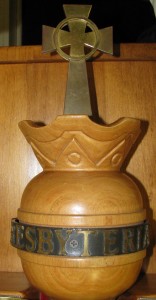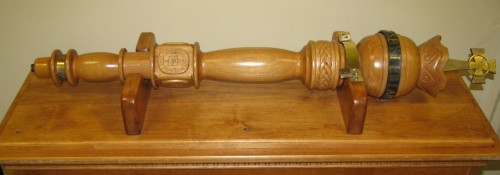The Presbyterian College Mace
March 2013
This semester we are fortunate to have an intern working with us in the Archives, Kirsten Witry of Clover, South Carolina. Kirsten is completing her senior year at Presbyterian College this May with a double major in German and History and a minor in English. In preparation for the inauguration of Dr. Claude C. Lilly in April, Kirsten has researched the college’s ceremonial mace and has written this column in order to share information about this symbolic object with our readers.

The brass Celtic cross on the head of the Presbyterian College ceremonial mace
This particular feature of Presbyterian College’s ceremonial events is a relatively recent addition. A mace was a weapon of medieval times, a long-handled club. It was carried by sergeants-at-arms to protect people of importance, as well as by certain church officials. According to the Encyclopedia Britannica, maces became more decorative in the fourteenth century. They were carried before mayors and bailiffs by the middle of the seventeenth century and began to be used by colleges in the sixteenth and seventeenth centuries. Universities all over the United States and in other countries, such as James Madison University and Ohio University, include a mace bearer in their processionals.
Dr. Neal Prater and his wife Marion, designed the mace of Presbyterian College at the request of President Ken Orr and Dean Bill Moncrief in 1994. Dr. Prater, who retired in 1996 after 36 years at the college, was the Charles A. Dana Professor of English. Mrs. Prater, who also retired in 1996 after 34 years and who passed away in 2001, was the head of the cataloging department at the James H. Thomason Library. She did most of the designing and was particularly concerned that the design relate to the Scottish and Presbyterian background of Presbyterian College.
The mace was crafted by Winnie Jørgensen, Helen Gibson, and Allen Mulkey at the John C. Campbell Folk School in Brasstown, North Carolina. The shaft is made of butternut wood and sports a brass Celtic cross on top of the molded head, which also has the name of the college on a decorative brass band. The college seal and motto are carved near the bottom of the mace. The carving is primitive to reflect the concept of a Scottish clansman. The mace was originally designed by Mrs. Prater to be much smaller, but Dr. Orr and Dr. Moncrief wished for it to be bulkier, to be more like a Scottish club. Dr. Prater says of this increase in size, “As I suspected, it is very heavy and a bit difficult to carry gracefully, but I imagine that those Scottish warriors probably were not much concerned with being graceful!”

The mace debuted at the Opening Convocation on September 6, 1994. It was carried by Dr. Prater, the faculty marshal who led the processional.

Many thanks to Dr. Neal B. Prater, Professor Emeritus of English, for providing the necessary information to bring our readers this post!
Kirsten Witry ‘13
Archives Intern
